100 days of Modi 3.0: Women-Led Development in the First 100 Days
A Transformative Journey
As India marches toward realizing Prime Minister Narendra Modi’s vision of becoming a developed nation by 2047, the government’s efforts are focused on ensuring no one is left behind—especially women. Recognizing the unique challenges faced by poor women, particularly in rural areas, the government has embarked on a series of transformative initiatives to empower them, harnessing their potential for national development.
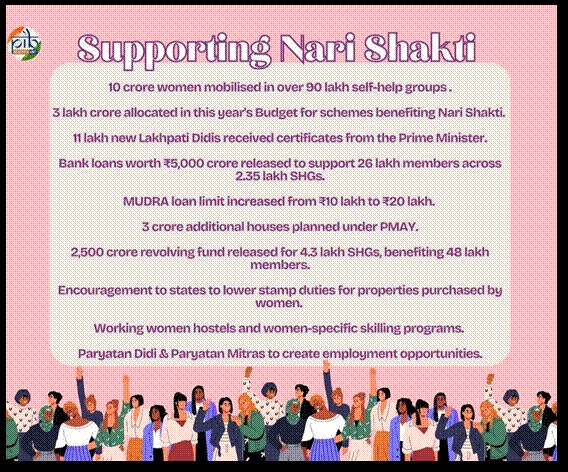
Deendayal Antyodaya Yojana-National Rural Livelihoods Mission
One of the most notable interventions has been through the Ministry of Rural Development’s Deendayal Antyodaya Yojana-National Rural Livelihoods Mission (DAY-NRLM). DAY-NRLM is the flagship program of Govt. of India for promoting poverty reduction through building strong institutions of the poor, particularly women, and enabling these institutions to access a range of financial services and livelihood services. DAY-NRLM is designed to be a highly intensive program and focuses on intensive application of human and material resources in order to mobilize the poor into functionally effective community owned institutions, promote their financial inclusion and strengthen their livelihoods.
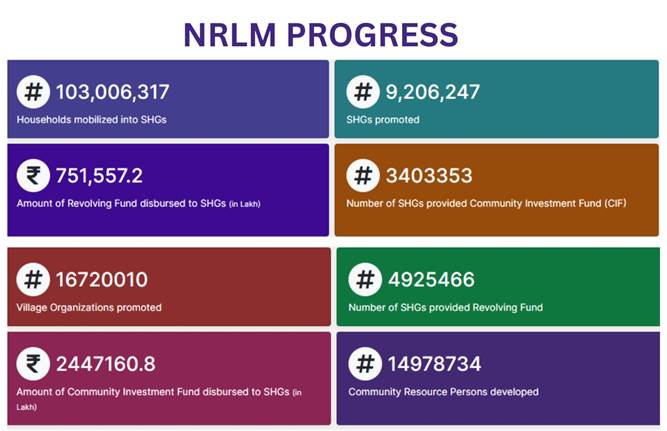
A women’s Self-Help Group (SHG), coming together on the basis of mutual affinity is the primary building block of the DAY-NRLM community institutional design. DAY-NRLM focuses on building, nurturing and strengthening the institutions of the poor women, including the SHGs and their Federations at village and higher levels. In addition, DAY-NRLM promotes livelihood institutions of rural poor. This mission has successfully mobilized over 10.03 crore women into more than 92.06 lakh self-help groups (SHGs). These SHGs serve as engines of financial inclusion, digital literacy, sustainable livelihoods, and social development for women across India. By integrating a holistic approach to livelihood development, DAY-NRLM has empowered women to break free from the cycle of poverty and contribute significantly to the nation’s growth.
Lakhpati Didi Yojana: Empowering Women Entrepreneurs
A Lakhpati Didi is a Self-Help Group member who earns an annual household income of Rupees One Lakh (Rs. 1,00,000) or more. This income is calculated for at least four agricultural seasons and/or business cycles, with an average monthly income exceeding Rupees Ten Thousand (Rs. 10,000), so that it is sustainable. The Prime Minister’s participation in the Lakhpati Didi Sammelan in Jalgaon, Maharashtra, further highlighted the government’s commitment to empowering women. During this event, PM Modi handed out certificates to 11 lakh women who became “Lakhpati Didis” during the government’s third term. Under the Lakhpati Didi Yojana, these women have achieved financial independence, with a goal set to make three crore women Lakhpati Didis in the coming years.
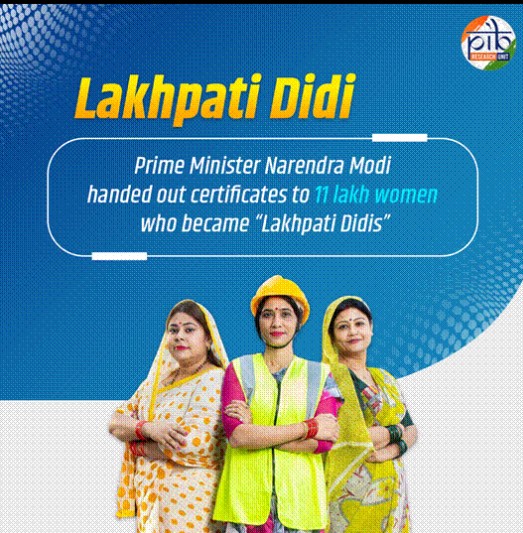
To further fuel this movement, the Prime Minister released a revolving fund of Rs 2,500 crore benefiting about 48 lakh members of 4.3 lakh Self-Help Groups and disbursed bank loans worth Rs 5,000 crore which will benefit 25.8 lakh members of 2.35 lakh SHGs. Since the inception of the Lakhpati Didi Yoajna, one crore women have already been made Lakhpati Didis and the government has set a target of three crore Lakhpati Didis.
This infusion of financial resources will provide the necessary support for women-led SHGs to expand their operations, improve their livelihoods, and create lasting economic growth in rural areas.
Union Budget 2024-25: A Focus on Nari Shakti
The Union Budget for 2024-25, presented by Finance Minister Nirmala Sitharaman, emphasized the critical role of Nari Shakti (women power) in India’s development. A notable Rs 3.3 lakh crore has been allocated across various ministries for women’s welfare and empowerment, which will boost participation in the workforce, enhance safety and security, and ensure an ecosystem of support through working women’s hostels and crèches. Several other key initiatives have been introduced to empower women across various sectors:
1. Working Women Hostels and Crèches: To support women’s participation in the workforce, the government will set up working women hostels in collaboration with industry and establish crèches. This will provide a safe and conducive environment for women to work while ensuring childcare support.
2. Skilling and Employment: A centrally sponsored scheme will be launched for skilling women in collaboration with state governments and industries. This initiative will skill 20 lakh youth over five years, which includes opportunities for women to enhance their employability and financial independence.
3. Mudra Loans: The limit for Mudra loans will be increased from ₹10 lakh to ₹20 lakh for women entrepreneurs who have successfully repaid previous loans. This will support women in expanding their businesses and increasing their economic participation.
4. Inclusive Economic Opportunities: Schemes like Stand-Up India, National Livelihood Missions, and PM Vishwakarma will be scaled up to support women entrepreneurs, artisans, and self-help groups (SHGs), ensuring broader access to financial resources and opportunities for women-led businesses.
5. Stamp Duty: As per the Union Budget 2024, the Union Government will encourage states to moderate high stamp duty rates and consider further lowering duties for properties purchased by women, making this reform an essential component of urban development schemes.
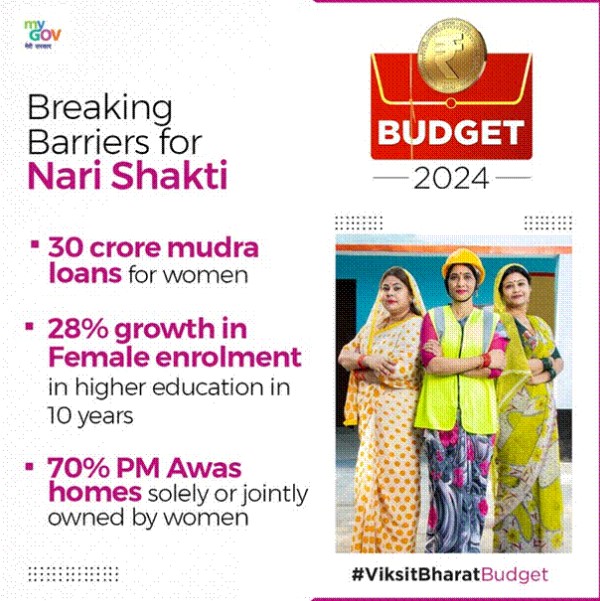
These initiatives collectively focus on enhancing the economic and social empowerment of women, helping them participate in India’s development story.
Additionally, Hon. Finance Minister Nirmala Sitharaman highlighted earlier in the Interim Budget that under the Pradhan Mantri Mudra Yojana (PMMY), 30 crore loans have been provided to women entrepreneurs, enabling them to launch and scale their businesses. Women’s enrollment in higher education has increased by 28%, and in STEM fields, girls and women now represent 43% of all students—one of the highest rates globally.
Pradhan Mantri Awas Yojana (PMAY): A Path to Women’s Empowerment
Housing is another area where the government has made significant strides in women’s empowerment. More than 70% of houses under the Pradhan Mantri Awas Yojana (PMAY) have been allocated to women, ensuring they have ownership and security over essential assets. In June 2024, after sanctioning 4.21 crore houses since the scheme’s inception, the government committed to constructing an additional 3 crore houses, further cementing its dedication to providing dignified living conditions for all citizens.
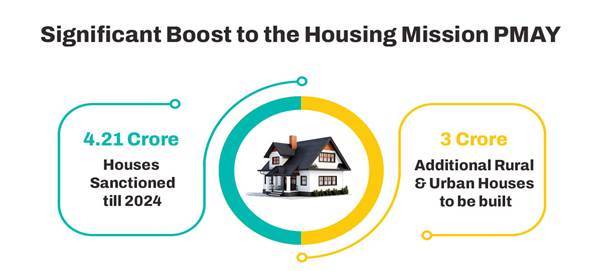
A key feature of PMAY is its focus on making women the owners or co-owners of houses, particularly for economically weaker sections and low-income groups. This not only provides women with financial security but also helps build their confidence and status within their communities. Furthermore, the scheme promotes environmentally sustainable and disaster-resilient construction practices, ensuring that rural housing is affordable, durable, and safe.
In addition to this, in order to ensure the quality of housing construction, the government has introduced nationwide training programs for rural masons, including women. These initiatives equip participants with the skills needed to construct resilient homes using locally available materials, empowering them to contribute to local economies and enhance their communities. Paryatan Didi & Paryatan Mitras initiatives have been started to create employment opportunities for women in the tourism sector.
A Collaborative Approach to Women-Led Development
Addressing the challenges faced by women in rural areas requires local knowledge and multi-stakeholder collaboration. Partnerships with NGOs, private organizations, and local communities have been pivotal in reaching the last mile and creating sustainable change. These partnerships ensure that women are equipped with the necessary tools and resources to lift themselves out of poverty, enhancing the overall development of rural India.
With the mantra of “Sabka Saath, Sabka Vikas, Sabka Vishwas,” the government’s holistic approach has laid a strong foundation for women-led development in its first 100 days. Through financial inclusion, social empowerment, housing security, and livelihood creation, India’s women are not only participants in but drivers of the nation’s growth story. As the government continues to push forward with these initiatives, the vision of a developed India by 2047, where no woman is left behind, is becoming increasingly achievable.
Zelenskyy to Press Biden for Long-Range Strike Approval in Washington Visit
Ukrainian President Volodymyr Zelenskyy is set to visit Washington next Thursday for talks…


















